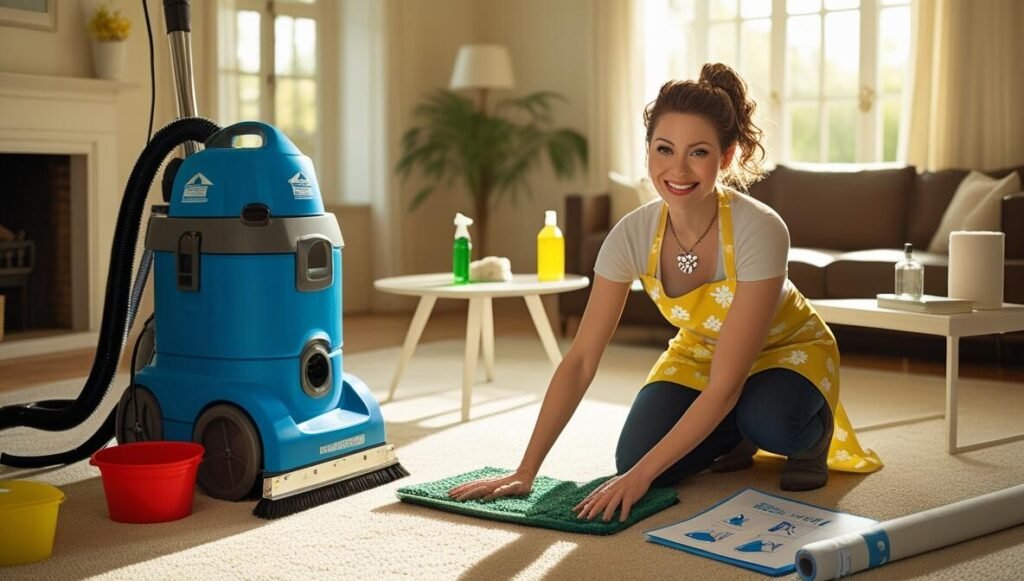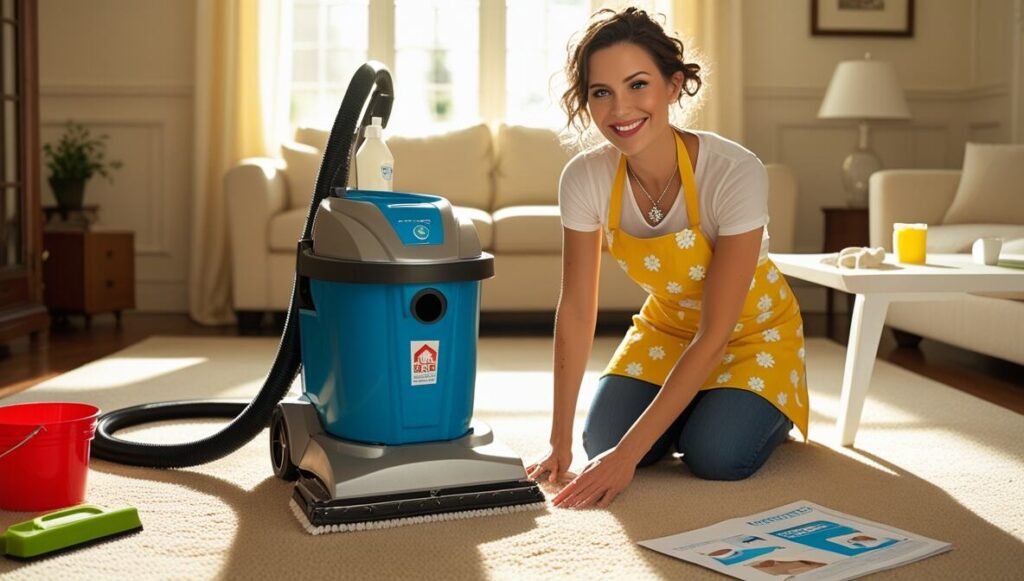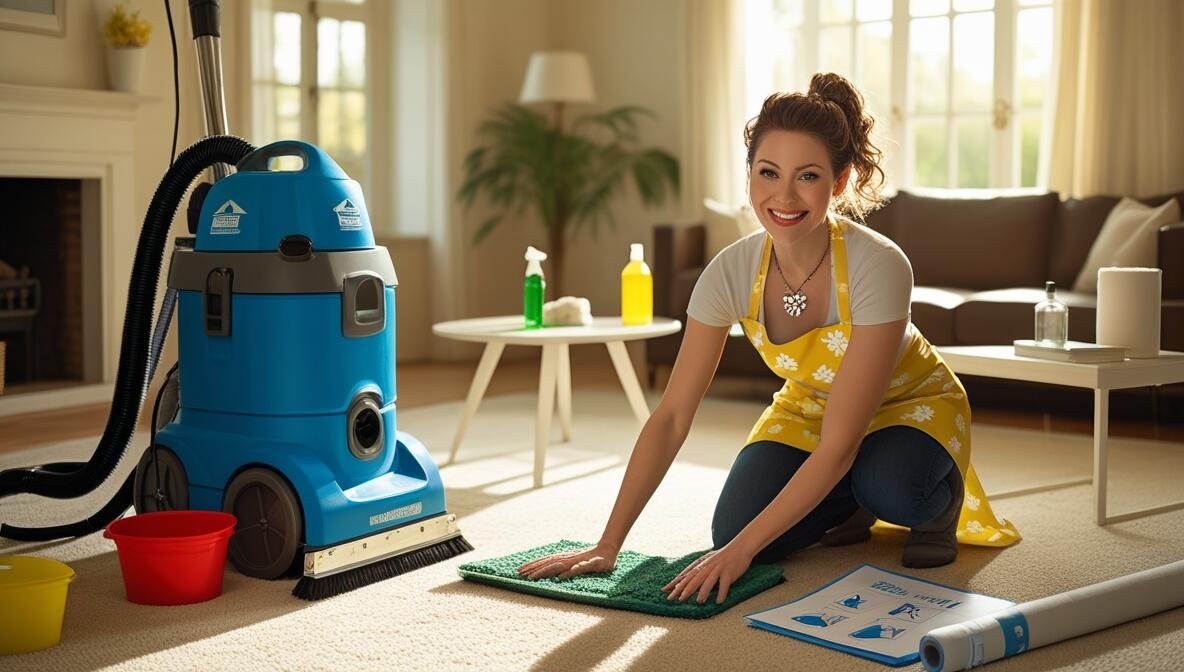After a deep clean, your carpet may feel fresh and spotless, but waiting for it to dry completely can be a challenge. A damp carpet not only feels uncomfortable but can also lead to musty odors, mold growth, and prolonged inconvenience. Knowing the best techniques to dry carpet after cleaning ensures a fast drying carpet while maintaining its freshness and longevity.
The carpet drying time can vary based on humidity, airflow, and carpet material, but there are proven ways to speed up carpet drying and get your floors back to normal faster. Whether you’ve just done a DIY carpet wash or had a professional cleaning, this guide will show you how to dry carpet after cleaning quickly and effectively.
Let’s dive into expert tips to ensure a fast-drying carpet and prevent moisture-related issues!

Why Proper Carpet Drying is Important
Ensuring your carpet dries thoroughly after cleaning is essential for maintaining a healthy and fresh home environment. If moisture lingers too long, it can create serious problems such as mold growth, unpleasant odors, and fabric damage. Here’s why taking the right steps to dry carpet fast is crucial:
1. Prevents Mold and Mildew Growth
Damp carpets create the perfect environment for mold and mildew, which can spread quickly and release allergens into the air. Drying wet carpet properly reduces the risk of health hazards, ensuring a cleaner and safer home for you and your family.
2. Avoids Bad Odors and Bacteria Buildup
When moisture gets trapped in carpet fibers, it can lead to musty smells and bacterial growth. A well-ventilated room and the right carpet drying techniques help prevent lingering odors and keep your indoor air fresh.
3. Extends the Lifespan of Your Carpet
Excess moisture weakens carpet fibers and can lead to premature wear and tear. Proper carpet drying not only protects your flooring investment but also keeps your carpet looking and feeling new for longer.
By using efficient drying techniques, such as increased airflow, dehumidifiers, and professional-grade fans, you can dry carpet fast and avoid potential damage. The next step is learning the best methods to speed up the carpet drying process—let’s explore them!
How Long Does It Take for Carpet to Dry?
Several factors determine how long it takes for a wet carpet to dry after cleaning. Understanding these elements can help you speed up carpet drying and prevent moisture-related issues. Here are the key factors that influence carpet drying time:
1. Carpet Material and Thickness
The type of carpet material and its thickness play a significant role in drying speed.
✔ Thicker, high-pile carpets (such as wool or shag rugs) retain more moisture and take longer to dry.
✔ Low-pile or synthetic carpets (like nylon or polyester) dry faster because they absorb less water.
✔ Carpets with dense padding underneath may also hold moisture longer, slowing the drying process.
2. Indoor Temperature and Humidity
The environment inside your home can significantly affect how quickly your carpet dries.
✔ High humidity levels slow down carpet drying, as moisture takes longer to evaporate.
✔ Warmer temperatures help water evaporate faster, leading to quicker drying.
✔ Using fans, air conditioners, or dehumidifiers can help regulate indoor conditions and dry carpet fast.
3. Cleaning Method Used (Steam Cleaning vs. Dry Cleaning)
The technique used to clean your carpet determines how much moisture is left behind.
✔ Steam cleaning involves hot water extraction, which deep cleans carpets but leaves them wetter, requiring a longer drying time (6-24 hours).
✔ Dry cleaning uses minimal moisture and a special cleaning powder, allowing carpets to dry almost immediately.
✔ Over-wetting during cleaning can prolong drying wet carpet times, making proper ventilation essential.
By understanding these factors, you can take the right steps to accelerate the carpet drying process and avoid unnecessary moisture buildup. Next, we’ll explore the best techniques to dry carpet after cleaning quickly and efficiently!

7 Best Ways to Dry Carpet After Cleaning
After cleaning your carpet, it’s crucial to dry carpet fast to prevent mold, mildew, and odors. Proper carpet drying methods can speed up carpet drying, ensuring your flooring is fresh, clean, and ready for use. Here are the most effective techniques for drying wet carpet quickly.
1. Increase Air Circulation
✔ Open windows and doors to allow fresh air to flow through your home, which helps dry carpet after cleaning more efficiently.
✔ Use ceiling fans to improve airflow and speed up carpet drying, especially in rooms with poor ventilation.
✔ If the outside air is humid, limit open windows and focus on indoor air circulation instead.
2. Use Fans for Faster Drying
✔ Position box fans or oscillating fans near damp areas to speed up carpet drying by increasing air movement.
✔ Adjust the fans so that they direct airflow toward the wet carpet, helping moisture evaporate faster.
✔ Keep fans running for at least a few hours to ensure effective carpet drying.
3. Turn on the HVAC System
✔ Set your air conditioner or heater to a moderate temperature to regulate indoor humidity and dry carpet fast.
✔ A properly running HVAC system will help keep air circulating, making the carpet drying process more effective.
✔ Avoid setting the temperature too high, as extreme heat may cause moisture to stay trapped in the carpet fibers.
4. Use a Dehumidifier
✔ A dehumidifier removes excess moisture from the air, making it one of the most efficient tools for dry carpet after cleaning.
✔ Ideal for homes in humid climates, where natural drying takes longer due to high moisture levels.
✔ Keep the dehumidifier running until the carpet drying process is complete and the floor feels completely dry.
5. Blot Excess Water with Dry Towels
✔ Lay clean, dry towels over wet areas to absorb excess moisture left after cleaning.
✔ Apply gentle pressure or walk over the towels to help extract trapped water from the carpet fibers.
✔ Replace damp towels with fresh ones as needed until the drying wet carpet process is nearly complete.
6. Use a Wet/Dry Vacuum
✔ A wet/dry vacuum is excellent for removing excess moisture from carpets, especially thicker ones that hold water.
✔ Slowly move the vacuum across the carpet, focusing on the dampest areas for effective carpet drying.
✔ Repeat the process multiple times until the carpet feels significantly drier.
7. Lift the Carpet Edges (If Necessary)
✔ If the carpet still feels damp underneath, carefully lift the edges to allow trapped moisture to escape.
✔ Place a fan or dehumidifier near the lifted section to speed up carpet drying and prevent mold growth.
✔ This step is especially useful if your carpet drying time is taking longer than expected.
Using these carpet drying methods will dry carpet fast and reduce the chances of moisture damage. Up next, we’ll explore additional precautions and maintenance tips to keep your carpets in excellent condition after drying.
Signs Your Carpet is Not Drying Properly
Even after following the best carpet drying methods, some carpets may take longer to dry due to poor ventilation, high humidity, or excessive moisture absorption. If you notice any of the following warning signs, your carpet may not be drying as it should, and immediate action is needed to prevent damage.
1. Musty Smell or Lingering Dampness
✔ A musty or damp odor is a clear indication that moisture is still trapped in your carpet.
✔ If the smell persists after 24 hours, mold or mildew may be forming, requiring urgent intervention.
✔ Running fans, dehumidifiers, or an HVAC system can help dry carpet fast and eliminate lingering dampness.
2. Visible Mold Spots or Discoloration
✔ Mold and mildew thrive in damp environments, and visible green, black, or white spots on your carpet indicate excess moisture.
✔ Discoloration may also appear if water damage is causing the carpet fibers to fade or stain.
✔ To prevent further issues, speed up carpet drying using high-powered fans, ventilation, and professional cleaning if necessary.
3. Sticky or Wet Carpet Fibers After 24 Hours
✔ If your carpet still feels sticky, soggy, or damp after a full day, it’s not drying properly.
✔ A fully dry carpet should feel soft and return to its natural texture.
✔ Use a wet/dry vacuum, dry towels, or a dehumidifier to extract any remaining moisture and speed up carpet drying.
If you notice any of these carpet drying issues, take immediate action to dry carpet fast and prevent long-term damage. In the next section, we’ll explore additional maintenance tips to keep your carpet fresh, clean, and moisture-free!
How can I speed up carpet drying time?
Increase air circulation by opening windows, using fans, and running a dehumidifier or HVAC system. A wet/dry vacuum can also help extract excess moisture faster.
Is it safe to use a hairdryer on wet carpet?
Using a hairdryer on low heat for small damp spots is fine, but it’s not ideal for larger areas. A fan, dehumidifier, or air mover is a safer and more effective option.
Can I place furniture back on the carpet before it dries?
No, placing furniture too soon can trap moisture and cause mold growth or carpet indentations. Wait at least 24 hours or until the carpet is fully dry.
Is heat or AC better to dry carpet?
Both can help, but AC reduces humidity, while heat speeds up evaporation. The best method is using moderate heat with proper airflow and ventilation.
Can you use salt to dry carpet?
Salt can absorb some moisture, but it’s not an effective method for drying large wet areas. Fans, dehumidifiers, and air circulation work much better.
Does baking soda dry carpet?
Yes, baking soda can help absorb moisture and eliminate odors. Sprinkle it over the damp area, let it sit for a few hours, then vacuum it up for best results.

Anamika is a passionate writer for Eco365Store.com, specializing in topics that inspire a cleaner, greener world. With expertise in home cleaning, recycling, and eco-friendly solutions, she crafts engaging and informative articles that help readers adopt sustainable practices in their daily lives.

